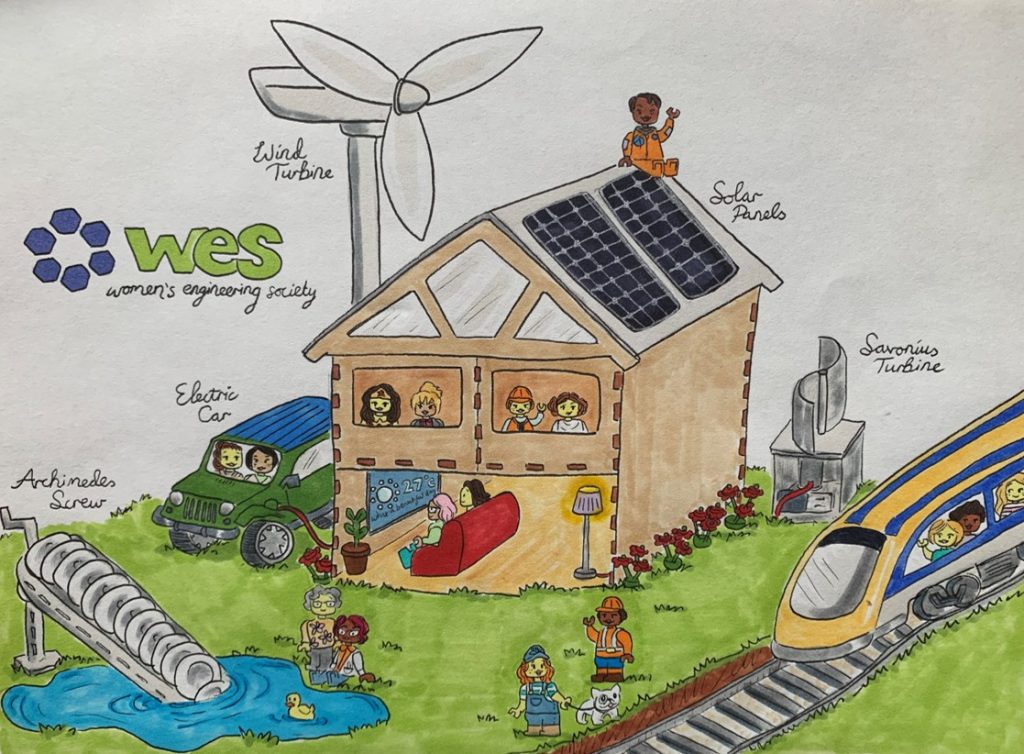Engineering is key to find answers to the challenges we face today! From the climate emergency to the medical and humanitarian response to the global pandemic, collaborating engineers are playing a significant role in developing solutions.
Newcastle University researchers, Dr. Jannetta Steyn and Laura Brown have worked together on a WES 100 Violets Public Engagement Challenge project, to illustrate the solutions and ideas engineers are applying to the global need for clean and affordable energy and integrating technology to improve the quality of our every life.

About WES
The Women’s Engineering Society (WES) is a charity and a professional network of women engineers, scientists and technologists offering inspiration, support and professional development. Working in partnership, it supports and inspires women to achieve as engineers, scientists and as leaders; they encourage the education of engineering; and support companies with gender diversity and inclusion.
About WES 100 Violets Challenge
The Women’s Engineering Society’s (WES) 100 Violets Challenge competition was part of their centenary celebrations in 2020. The aim was to design and build an engaging museum exhibit that celebrates and showcases engineering/research and shares it with the public. The challenge is supported by the Ingenious Grant program from the Royal Academy of Engineering.
The exhibit idea
The aim of the exhibit was to showcase electrical, software, computing, mechanical, building and energy engineering. The Public would be able to interact with the exhibit to provide an insight into how things work and what is involved in developing the technologies that make our way of life possible without impacting the planet.
Essentially the team would be building a model of a typical house but integrated with some of the established and emerging engineering and computer science innovations that are providing a route to sustainable living.
The building model was inspired by a family history project carried out by Dr. Steyn of a house that was built by her ancestors in South Africa in 1850 in the Cape Province.
- The prototype was designed using Inkscape
- A lasercutter was used to cut it from 3mm Birch plywood
- The thatch roof used coconut fibre and the ridge was cut strips from a hanging flower basket lining
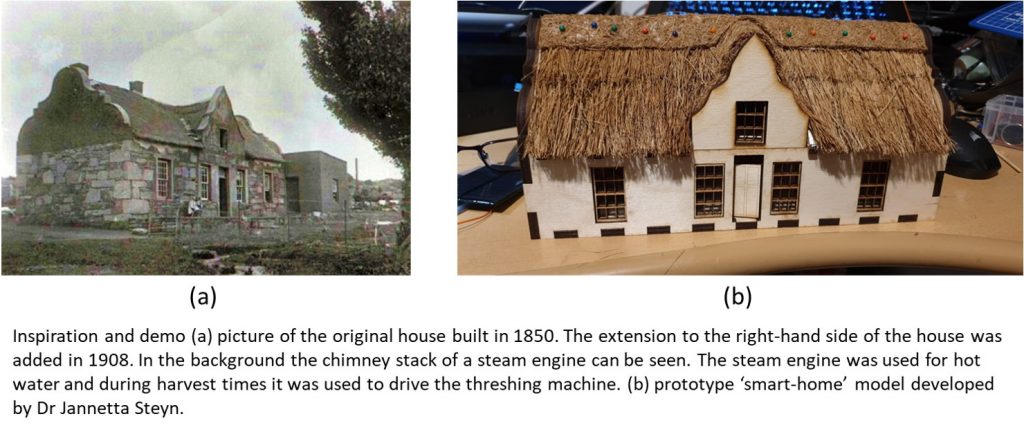
The final model was informed by the research being carried out at the EPSRC National Centre for Energy System Integration (CESI) which both project team members participate in. CESI is investigating the value in taking an energy systems integration approach to the future energy system and evaluating the security, economic and environmental costs of the future energy and transport scenarios being considered for the UK.
More Technical Details about the project can be found in a series of blogs developed by Jannetta at her personal blog site: – brainwaves.jannetta.com
About the Project Team: Dr Jannetta Steyn
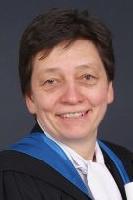
Jannetta is a Research Software Engineer at the Digital Institute, Newcastle University. As an experienced researcher and software engineer she has a background in data analysis, provenance and middleware programming. Jannetta does a large amount of outreach work, primarily in STEM, running a range of coding clubs and electronics clubs.
Contact:- Jannetta.Steyn@newcastle.ac.uk
http://brainwaves.jannetta.com/
About the Project Team: Laura Brown
Laura is the Centre Manager, EPSRC National Centre for Energy Systems Integration and Energy Research Programme Manager, Newcastle University. Her research tackles the challenges of integration of state-of-the-art thinking and technology into legacy and future energy systems. Laura sits on the Tees and Tyne Regional Cluster Committee of the Women’s Engineering Society and is the group leader of the SDG7 subgroup of the WES Climate Emergency Group.
Contact:- laura.brown11@newcastle.ac.uk
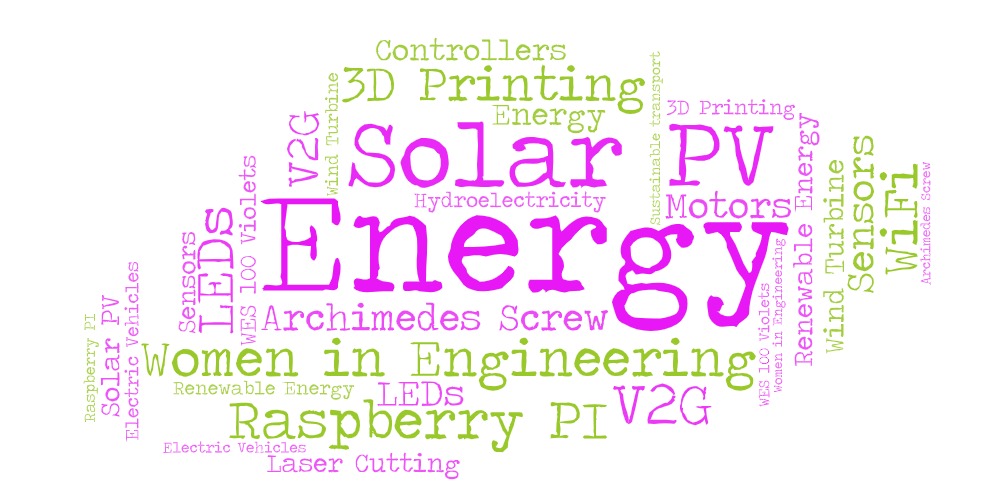
Training and Early Engagement
To help give us expertise the tricky art of public engagement and science communication, the WES 100 Violets Challenge Group organised two expert training sessions from a wonderful team of Science Communicator experts from Science Made Simple. The trainers gave us top tips on body language, communication tools and invalable guidance on the Health and Safety considerations of planning a public exhibit. We also got the chance to meet the other winners of the 100Violets Challenge and hear about their inventive ideas.
And to practice our new science communications skills, we organised an event with the students and staff of the School of Engineering at Newcastle University. As part of our exhibit were some elements of lego energy systems, we thought the students (and staff) would have fun helping us construct the model. And for extra measure, we borrowed some resources from our colleagues at Open Lab to allow some free lego building. The event was great fun and I’m pleased our research confirmed our hypothesis – engineers love playing with lego !!! What do you think of the results?
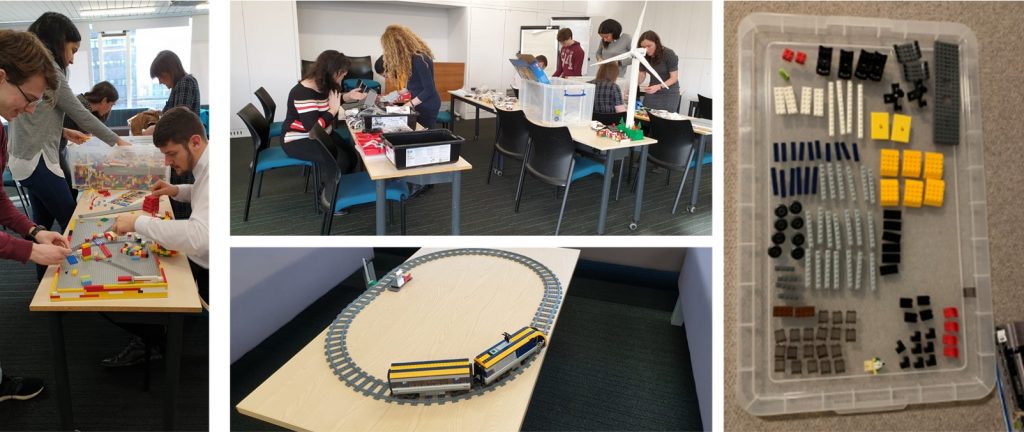
Gender Equality in Engineering
We aren’t sure who coined the phrase, “if you can’t see it, you can’t be it” as a rallying call to have positive role models from all sections of society in all walks of life but we felt even in this relatively light-hearted project there was some evidence of gender bias in the system. When we procured the rather fabulous lego wind turbine we were somewhat crestfallen when the two technicians were both males! That error was quickly fixed by some immediate head swaps. We then used this as a theme in the model that all the roles in the exhibit tableau would be engineers – a non-gendered noun.

The end of the beginning
By this time the model was starting to take shape. (More technical details can be found in a series of blogs developed by Jannetta blog site: – brainwaves.jannetta.com ).
- We had a date in the calendar for the big WES 100 Violets Exhibition
- We had procured all the parts of the model and constructed all the lego components
- 3D printing and Laser Cutting of the House was going well
- The IoT Smart Home was beginning to take shape
- The EV had been built and was (remotely) operational
- We had developed some engaging learning materials to accompany our exhibit
- Science Made Simple team had helped us perfect our Exhibition Pitch for our intended audience
- We had our first engagement event with the students (guinea pigs) completed and it had went well
- Our fabulous colleague Faye Harland had provided an amazing schematic of our planned model (See below)
- We had another local exhibition planned …
- It was February 2020 … it was all in hand … what could possibly go wrong …
… we suspect you can guess but we will provide some more of the story next week in our next blog. To be continued …
